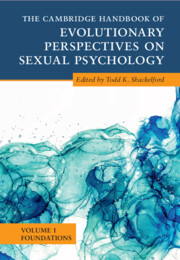Book contents
- The Cambridge Handbook of Evolutionary Perspectives on Sexual Psychology
- The Cambridge Handbook of Evolutionary Perspectives on Sexual Psychology
- Copyright page
- Contents
- Contributors
- Preface
- Part I Foundations of Evolution
- 1 Natural Selection
- 2 Sexual Selection
- 3 Inclusive Fitness Theory
- 4 Adaptive Problems in the Domain of Human Sexuality
- 5 Adaptations, By-products, and Spandrels
- 6 Evolved Psychological Mechanisms
- Part II Middle-Level Theories
- Index
- References
6 - Evolved Psychological Mechanisms
Properties and Evidence, Misconceptions and Mismatches
from Part I - Foundations of Evolution
Published online by Cambridge University Press: 30 June 2022
- The Cambridge Handbook of Evolutionary Perspectives on Sexual Psychology
- The Cambridge Handbook of Evolutionary Perspectives on Sexual Psychology
- Copyright page
- Contents
- Contributors
- Preface
- Part I Foundations of Evolution
- 1 Natural Selection
- 2 Sexual Selection
- 3 Inclusive Fitness Theory
- 4 Adaptive Problems in the Domain of Human Sexuality
- 5 Adaptations, By-products, and Spandrels
- 6 Evolved Psychological Mechanisms
- Part II Middle-Level Theories
- Index
- References
Summary
Understanding evolved psychological mechanisms (EPMs) is important for social scientists seeking a comprehensive understanding of human behavior and cognition. In this chapter we discuss the origins of EPMs, describing their functioning and situational sensitivity. We also discuss how EPMs offer a valuable framework for integrating proximate and distal explanations of psychological phenomena. We then describe methodologies and evidence that can be used to identify EPMs, before concluding with a discussion of how certain EPMs are mismatched with conditions of modern living, potentially interfering with the goal of a happy and healthy life.
Keywords
- Type
- Chapter
- Information
- Publisher: Cambridge University PressPrint publication year: 2022

